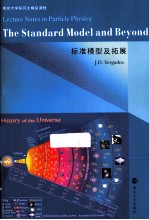图书介绍
标准模型及拓展PDF|Epub|txt|kindle电子书版本网盘下载

- J. D. Vergados主编 著
- 出版社: 南京:南京大学出版社
- ISBN:9787305136337
- 出版时间:2014
- 标注页数:248页
- 文件大小:23MB
- 文件页数:259页
- 主题词:粒子物理学-研究生-教材-英文
PDF下载
下载说明
标准模型及拓展PDF格式电子书版下载
下载的文件为RAR压缩包。需要使用解压软件进行解压得到PDF格式图书。建议使用BT下载工具Free Download Manager进行下载,简称FDM(免费,没有广告,支持多平台)。本站资源全部打包为BT种子。所以需要使用专业的BT下载软件进行下载。如BitComet qBittorrent uTorrent等BT下载工具。迅雷目前由于本站不是热门资源。不推荐使用!后期资源热门了。安装了迅雷也可以迅雷进行下载!
(文件页数 要大于 标注页数,上中下等多册电子书除外)
注意:本站所有压缩包均有解压码: 点击下载压缩包解压工具
图书目录
1 Introduction to Particle Physics1
1.1 The natural System of Units1
1.2 The Planck Natural system of units4
1.3 Invariants in kinematics5
1.4 Cross sections and Luminosities7
1.4.1 Luminosity for fixed target experiments7
1.4.2 Luminosity for colliding beam experiments8
1.5 Kinematics of particle decay10
1.6 Invariants in the scattering of two particles11
1.7 Transformation properties of non invariant quantities14
2 Elements of Group Theory17
2.1 Definitions17
2.2 Matrix groups18
2.2.1 The exponential of a matrix20
2.2.2 Determination of the independent parameters23
2.3 The structure constants26
2.4 Representations27
2.4.1 The fundamental representation27
2.4.2 The adjoined representation30
2.5 Homomorphism-isomorphism32
2.6 Some further examples33
2.7 The proper orthogonal groups O(3)and O(4)35
2.8 Symmetries and conservation laws-Noether's theorem39
3 The Dirac Theory45
3.1 Preliminaries-The Klein Gordon equation45
3.2 The Dirac equation47
3.2.1 The spinors u and v49
3.2.2 Projection operators52
3.2.3 Various representations of the Dirac Matrices52
3.3 Interpretation of negative energy solutions53
3.4 The notion of helicity54
3.5 Charge conjugation for 4-spinors57
3.6 Types of currents58
4 The standard Model-Symmetry and particle content61
4.1 The essential ingredients61
4.2 The notion of a local symmetry61
4.3 Non Abelian gauge transformation63
4.3.1 Transformations associated with a non Abelian group64
4.3.2 Some Examples65
4.4 Gauge invariant Lagrangians67
4.4.1 Only gauge fields67
4.4.2 Lagrangian in the presence of scalar fields69
4.4.3 Lagrangian in the presence of fermion fields70
4.5 The particle content of the SM70
4.6 The electroweak Lagrangian71
5 The Higgs Mechanism73
5.1 The Higgs Mechanism in global gauge transformations73
5.2 The Higgs Mechanism in gauge theories79
5.3 Fundamental theorem of Higgs Mechanism87
6 The Group SU(3)-Quantum Chromodynamics89
6.1 Quantum chromodynamics QCD89
6.2 The one gluon exchange potential92
6.2.1 Proeess involving only baryons92
6.2.2 processes involving the creation of a q? pair93
6.2.3 processes involving interaction of mesons93
6.3 Low energy formalism94
6.3.1 The orbital part at the quark level95
6.3.2 The kinetic energy part95
6.3.3 The confining potential95
6.3.4 Fitting the strength of the confining potential96
6.4 Matrix elements involving two quarks97
6.4.1 The confining potential97
6.4.2 The one gluon exchange potential97
7 Fermion Masses and Currents99
7.1 Fermion masses99
7.2 The currents103
7.2.1 The EM current105
7.2.2 The charged currents105
7.2.3 The neutral currents106
7.3 The contact interaction108
7.4 Determination of the Standard Model Parameters109
7.5 Summary110
8 Rates and Cross Sections in Electroweak Theory111
8.1 Brief review and formulae111
8.2 Decay widths and cross section112
8.2.1 The decay of a vector boson113
8.3 Muon-antimuon production in electron-positron colliders117
8.4 neutrino electron scattering120
9 Supersymmetry for Pedestrians125
9.1 Introduction125
9.2 The particle content of MSSM126
9.2.1 gauge particles126
9.2.2 Fermions and s-fermions127
9.2.3 The Higgs content127
9.3 The Higgs mechanism127
9.4 The Fermion masses130
9.5 Supersymmetry breaking132
9.6 Some remarks about the particle spectrum132
10 SU(5)An Example of Grand Unification137
10.1 Mathematical Introduction137
10.2 The structure of the GUT SU(5)137
10.3 The particle content139
10.3.1 The Fermions139
10.3.2 The gauge bosons140
10.3.3 The Higgs content141
10.4 The Higgs Mechanism141
10.5 The gauge boson masses144
10.6 Gauge couplings144
10.7 Baryon Asymmetry146
11 A Brief Introduction to Cosmology151
11.1 Cosmological Principles151
11.2 The expanding Universe-The big bang scenario151
11.2.1 The receding of galaxies152
11.2.2 The background microwave radiation155
11.2.3 The abundance of primordial 4He and other light elements in the Universe156
11.3 Evolution of the Universe157
11.4 The Cosmological Constant-Dark Energy161
11.5 The standard cosmological model164
11.6 The proper length and the horizon165
11.6.1 The proper length entering the prototype candles166
11.6.2 The horizon167
11.7 temperature168
11.7.1 The relic neutrinos170
11.8 The role of dark matter174
11.8.1 The rotational velocities174
11.8.2 Gravitational lensing178
11.8.3 The observation of bullet cluster178
11.9 Dark energy181
11.9.1 Observations with standard candles182
11.9.2 The microwave background radiation-The earliest picture of the Universe184
11.10 The WMAP and PLANCK Observations188
12 Neutrino oscillations193
12.1 Introduction193
12.2 The formalism194
12.3 Neutrino oscillation experiments196
12.4 The absolute scale of the neutrino mass203
12.5 Neutrinos as probes209
13 C,P,T and all that211
13.1 Space inversion P211
13.1.1 Parity conservation-parity violation214
13.2 The helicity of the neutrinos217
13.2.1 The determination ofthe helicity of neutrinos219
13.2.2 Weak interaction and handedness221
13.3 Charge Conjugation221
13.3.1 Charge conjugation for 4-spinors223
13.3.2 Transformation of currents224
13.3.3 Symmetry relation of the Dirac nass term224
13.3.4 Symmetry relation of the Majorana mass term225
13.3.5 The charge conjugation of composite systems225
13.3.6 How good a symmetry is the charge conjugation?226
13.4 Time reversal227
13.4.1 Time reversal in classical mechanics227
13.4.2 Time reversal in quantum mechanics229
13.4.3 Premature evidence for T violation231
13.5 CP the combined action of P and C symmetries231
13.5.1 The neutral Kaon system233
13.5.2 Strangeness oscillations236
13.5.3 Kaon regeneration236
13.5.4 CP Violation239
13.5.5 Evidence for T-violation243
13.6 The combined symmetry CPT244